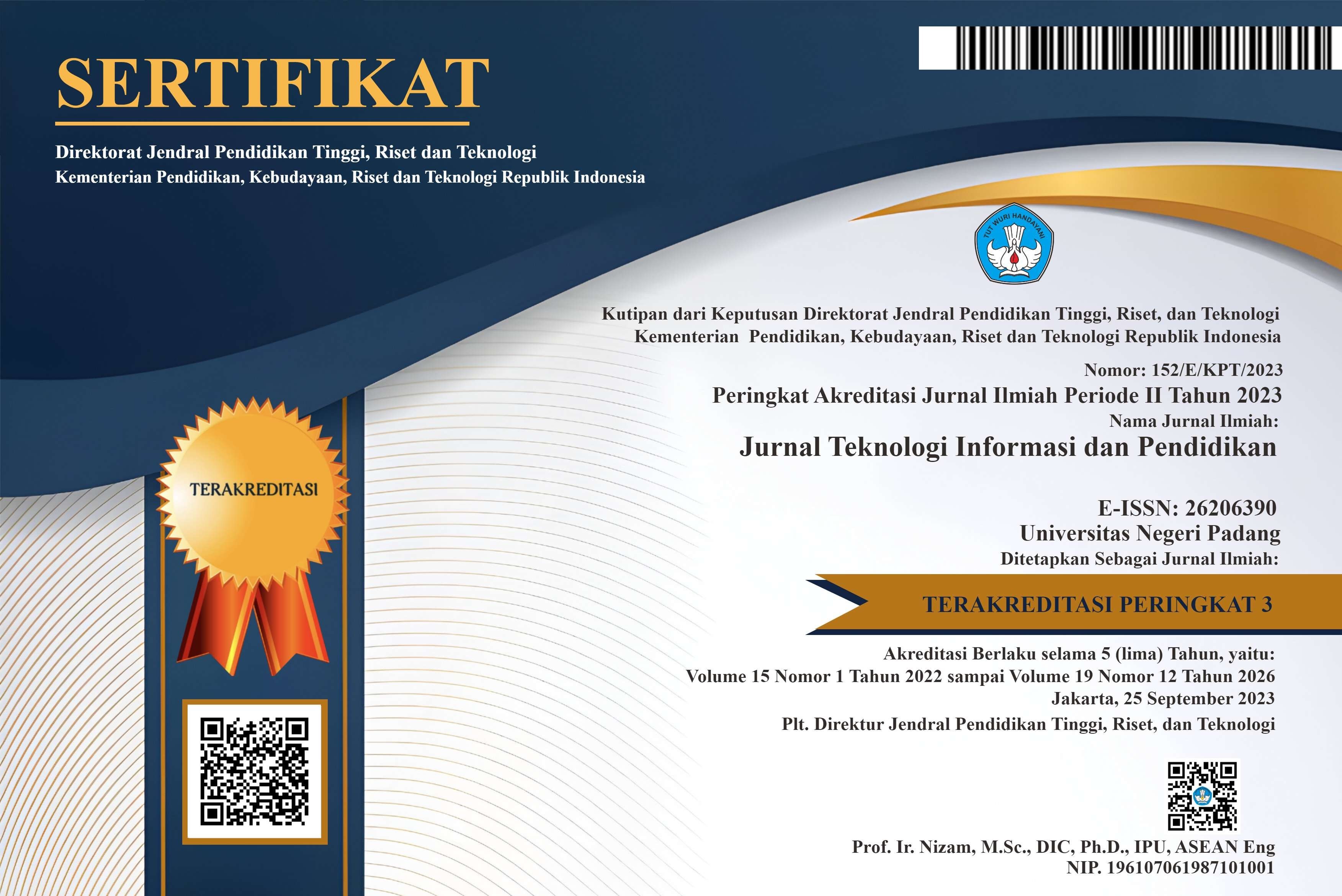Analysis of Mobile Banking Acceptance in Indonesia using Extended TAM (Technology Acceptance Model)
Abstract
The use of Communication and Information Technology which is developed through the years is one of the key of organization’s success in business rivalry through pandemic era nowadays. In line with the development of technology and information, bank authorities also offer the facility of banking through mobile banking (m-banking) application that can be accessed by using smartphone. This research aims to analyze factors that can influence the acceptance of m-banking application in Indonesia. The data was gathered through survey of 412 m-banking users in Indonesia and it was analyzed by using Structural Equation Modeling (SEM) with Extended Technology Acceptance Model (TAM). The findings of the research showed positive attitudes, perceived usefulness and perceived ease of use felt by the m-banking users and become the main reasons in adopting this technology besides social influence and perceived risk of m-banking technology. Meanwhile, the fear of using technology in using m-banking technology has a potential to obstruct the technology adoption. The result of this research can help the bankers and stakeholder in formalizing strategical steps in improving the adaptation of m-banking technology and application, especially in Indonesia.
References
Levani, Prastya, and Mawaddatunnadila, “Coronavirus Disease 2019 (COVID-19): Patogenesis, Manifestasi Klinis dan Pilihan Terapi,” Jurnal Kedokteran dan Kesehatan, vol. 17, no. 1, pp. 44–57, 2021.
R. Nasruddin and I. Haq, “Pembatasan Sosial Berskala Besar (PSBB) dan Masyarakat Berpenghasilan Rendah,” SALAM: Jurnal Sosial dan Budaya Syar-i, vol. 7, no. 7, 2020, doi: 10.15408/sjsbs.v7i7.15569.
L. Zhang, J. Zhu, and Q. Liu, “Author ’ s personal copy Computers in Human Behavior,” 2012.
I. Tirtana and S. P. Sari, “Analisis Pengaruh Persepsi Kebermanfaatan, Persepsi Kemudahan dan Kepercayaan terhadap Penggunaan Mobile Banking,” Seminar Nasional dan Call For Paper, vol. 25, pp. 671–688, 2014.
I. N. Resita and Z. Baridwan, “DETERMINAN INDIVIDU TERHADAP PENGGUNAAN MOBILE BANKING: PENDEKATAN TECHNOLOGY ACCEPTANCE MODEL (TAM) (Studi pada Masyarakat Pengguna Mobile Banking di Kabupaten Lamongan),” Jurnal Ilmiah Mahasiswa Fakultas Ekonomi dan Bisnis, vol. 151, pp. 10–17, 2015, doi: 10.1145/3132847.3132886.
T. Oliveira, M. Thomas, G. Baptista, and F. Campos, “Mobile payment: Understanding the determinants of customer adoption and intention to recommend the technology,” Comput Human Behav, vol. 61, pp. 404–414, 2016, doi: 10.1016/j.chb.2016.03.030.
T. Apanasevic, J. Markendahl, and N. Arvidsson, “Stakeholders’ expectations of mobile payment in retail: lessons from Sweden,” 2016.
A. Hossain, R. Quaresma, and H. Rahman, “Investigating factors influencing the physicians’ adoption of electronic health record (EHR) in healthcare system of Bangladesh: An empirical study,” Int J Inf Manage, vol. 44, no. May 2018, pp. 76–87, 2019, doi: 10.1016/j.ijinfomgt.2018.09.016.
N. P. Rana, Y. K. Dwivedi, M. D. Williams, and V. Weerakkody, “Investigating success of an e-government initiative: Validation of an integrated IS success model,” Information Systems Frontiers, vol. 17, no. 1, pp. 127–142, 2014, doi: 10.1007/s10796-014-9504-7.
Y. K. Dwivedi, N. P. Rana, A. Jeyaraj, M. Clement, and M. D. Williams, “Re-examining the Unified Theory of Acceptance and Use of Technology (UTAUT): Towards a Revised Theoretical Model,” Information Systems Frontiers, vol. 21, no. 3, pp. 719–734, 2019, doi: 10.1007/s10796-017-9774-y.
P. Lemenkova, “Statistical analysis of the mariana trench geomorphology using R programming language,” Geodesy and Cartography (Vilnius), vol. 45, no. 2, pp. 57–84, 2019, doi: 10.3846/gac.2019.3785.
J. Stander and L. Dalla Valle, “On enthusing students about big data and social media visualization and analysis using R, RStudio, and RMarkdown,” Journal of Statistics Education, vol. 25, no. 2, pp. 60–67, 2017, doi: 10.1080/10691898.2017.1322474.
Yves. Rosseel, “Lavaan: An R Package for Structural Equation Modeling,” JournalofStatisticalSoftware May, vol. 48, no. 2, 2012.
M. Abad, I. Díaz, and M. Vigo, “Acceptance of mobile technology in hedonic scenarios,” Proceedings of the 2010 British Computer Society Conference on Human-Computer Interaction, BCS-HCI 2010, pp. 250–258, 2010, doi: 10.14236/ewic/hci2010.31.
A. R. Pratama, “Fun first, useful later: Mobile learning acceptance among secondary school students in Indonesia,” Educ Inf Technol (Dordr), vol. 26, no. 2, pp. 1737–1753, 2021, doi: 10.1007/s10639-020-10334-w.
S. C. Chang, C. C. Sun, L. Y. Pan, and M. Y. Wang, “An Extended TAM to Explore Behavioural Intention of Consumers to Use M-Commerce,” Journal of Information and Knowledge Management, vol. 14, no. 2, pp. 1–16, 2015, doi: 10.1142/S0219649215500148.
J. Sarwono, “Pengertian Dasar Structural Equation Modeling ( SEM ),” Jurnal Ilmiah Manajemen Bisnis, pp. 173–182, 2010.
F. D. Davis, R. P. Bagozzi, and P. R. Warshaw, “User Acceptance of Computer Technology: A Comparison of Two Theoretical Models,” Manage Sci, vol. 35, no. 8, pp. 982–1003, 1989, doi: 10.1287/mnsc.35.8.982.
P. G. Schierz, O. Schilke, and B. W. Wirtz, “Understanding consumer acceptance of mobile payment services: An empirical analysis,” Electron Commer Res Appl, vol. 9, no. 3, pp. 209–216, 2010, doi: 10.1016/j.elerap.2009.07.005.
W. Widiyanti, “Pengaruh Kemanfaatan, Kemudahan Penggunaan dan Promosi terhadap Keputusan Penggunaan E-Wallet OVO di Depok,” Moneter - Jurnal Akuntansi dan Keuangan, vol. 7, no. 1, pp. 54–68, 2020, doi: 10.31294/moneter.v7i1.7567.
P. G. Schierz, O. Schilke, and B. W. Wirtz, “Understanding consumer acceptance of mobile payment services: An empirical analysis,” Electron Commer Res Appl, vol. 9, no. 3, pp. 209–216, 2010, doi: 10.1016/j.elerap.2009.07.005.
S. K. Sharma, S. K. Mangla, S. Luthra, and Z. Al-Salti, “Mobile wallet inhibitors: Developing a comprehensive theory using an integrated model,” Journal of Retailing and Consumer Services, vol. 45, no. August, pp. 52–63, 2018, doi: 10.1016/j.jretconser.2018.08.008.
V. Venkatesh, J. Y. L. Thong, and X. Xu, “Consumer Acceptance and Use of Information Technology,” MIS Quarterly, vol. 36, no. 1, pp. 157–178, 2012.
C. Kim, W. Tao, N. Shin, and K. S. Kim, “An empirical study of customers’ perceptions of security and trust in e-payment systems,” Electron Commer Res Appl, vol. 9, no. 1, pp. 84–95, 2010, doi: 10.1016/j.elerap.2009.04.014.
S. K. Sharma, S. K. Mangla, S. Luthra, and Z. Al-Salti, “Mobile wallet inhibitors: Developing a comprehensive theory using an integrated model,” Journal of Retailing and Consumer Services, vol. 45, no. August, pp. 52–63, 2018, doi: 10.1016/j.jretconser.2018.08.008.
D. F. Fornell, C., & Larcker, “Evaluating structural equation models with unobservable variables and measurement error,” Journal of Marketing Research This, vol. 18, no. 1, pp. 39–50, 2016.
L. T. Hu and P. M. Bentler, “Cutoff criteria for fit indexes in covariance structure analysis: Conventional criteria versus new alternatives,” Structural Equation Modeling, vol. 6, no. 1, pp. 1–55, 1999, doi: 10.1080/10705519909540118.
Copyright (c) 2023 Jurnal Teknologi Informasi dan Pendidikan

This work is licensed under a Creative Commons Attribution-ShareAlike 4.0 International License.















.png)














